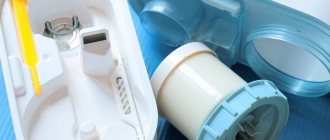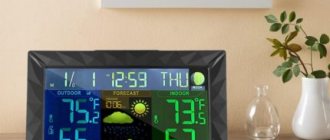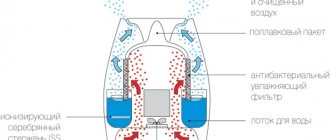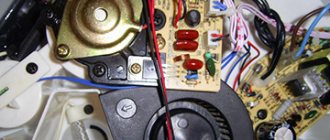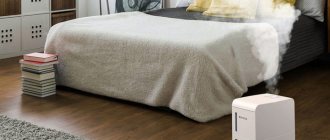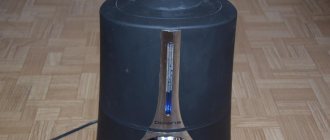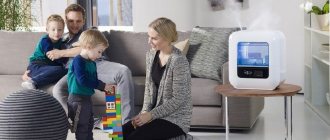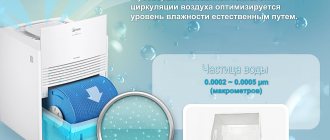Electrical problems
Short circuits and other electrical problems are very common.
This often occurs due to the user’s fault or due to damage to the device due to a fall. If everything is clear with the last reason - the device has fallen, the gasket may have moved, or part of the housing may have cracked, then the first one needs to be clarified. The air humidifier circuit has two technological holes with which the user interacts. Water is poured into one, steam comes out of the other. Most appliance owners have no idea how the appliances work inside. Therefore, attempts to pour liquid through the steam outlet holes are repeated quite often.
The red arrow points to the water hole
To repair a humidifier from Electrolux, Boneko or any other brand that shows no signs of life, you must first (disconnect the device from the mains) check:
- availability of power supply in the outlet;
- condition of the fuse in the plug, which is equipped with models from Venta;
- integrity of the power cable;
- absence of wire fractures at the points where they exit the plug and enter the housing;
If possible, you should try to turn on the humidifier by replacing the power supply if the model is powered by a voltage converter.
If everything is in order, but the humidifier does not work, you need to open the case (more on this below). Having gained access to the inside of the device, it is worth inspecting it for the presence of moisture. If it is, you will have to deal with the electrical part. Eliminating this problem requires the intervention of specialists.
However, the humidifier may not start because the automatic protection is blocked. To make sure that this reason does not exist, you need to inspect all parts of the device that use electricity. There should be no blackening or parts with uneven color on the control board; the fan coils, if visible, should also have a uniform color.
If everything is visually in order, you should remove all moisture from the inside of the device and dry it thoroughly for 24 hours. Such repairs help restore the functionality of humidifiers in most cases.
Occurring work moments
When operating an air humidifier, there are some operating moments when the device needs to be repaired. Let's look at the most common ones.
Stench from the device
When the room smells bad while the device is running, the problem is in the membrane. It should be taken out and cleaned. The procedure is almost the same for different models. The device is disconnected from the network, the back panel is removed. The screed is removed, the lower roller is pulled out of the membrane and the upper roller is removed. Depending on the condition, the membrane is either changed or washed with soap and water, dried and returned to its place.
No steam
In cases where no steam comes out of the humidifier when it is turned on, you should again check the condition of the membrane. It needs to be changed or washed, as in the case of an unpleasant odor. The cause may also be a faulty engine. It also changes easily. To repair an ultrasonic air humidifier, in particular to check the operation of the motor, a mark is made on the drive roller. The device is assembled and turned on for a short period of time. Then check the rotation of the roller. If it does not happen, the device needs to replace the motor. It can be removed by unscrewing the fastening bolts and disassembling the power cord terminals.
No air coming in
What to do when the device is turned on, but no air comes out of it? The reason is that the air holes are clogged. Replacing the air intake grille filter helps here. Or there could be a problem with the fan. If its rotation does not look normal, you should contact service. The reason may also be in the engine, which needs to be replaced.
If necessary, you can repair the humidifier yourself
Sometimes the reason lies in loose contacts of the internal wiring. They should be tightened up. If there are no visible violations, you need to take your device to a specialist.
Doesn't work at all
In cases where the humidifier switches off periodically, the problem exists in the sensor. He is replaced by a specialist. Why does the device not work, and how to fix the humidifier? Sometimes the device does not turn on because there is no power supply to it. You should check the presence of current in the network - fuses, circuit breaker, voltage. The fuse is changed. If it often burns out, you need to contact the experts. You need to check that the connections in the plug are correct. The power cord may be broken. It should be “ringed” with a tester and replaced. Sometimes water leaks from the humidifier. Most likely, the container needs to be changed.
Now you know how to clean the device, how to care for it, what detergent can be used to clean it, and what to do if a problem is found. Be sure to follow the safety precautions given in the instructions for the device. Whatever type of humidifier you have, you need to clean it, disinfect it and, if necessary, repair it.
Prevention of the problem
To ensure that your humidifier lasts as long as possible, you need to follow these simple rules:
- water should only be poured through a hole designed specifically for this purpose;
- It is recommended to use only distilled or purified water;
- the fluid must be changed every day;
- the water tank needs to be washed regularly, but without using detergents;
- filters need to be cleaned periodically;
- Do not fill the device with any liquid other than water;
- the permissible liquid threshold must not be exceeded;
- the humidifier is not an inhaler, so bending over it and inhaling steam is prohibited;
- disinfection of the climate control unit can be carried out using vinegar, but during this procedure the windows should be kept open;
- the humidifier should not be placed in close proximity to other household appliances to prevent damage to them;
- To disassemble and check the device, you must first unplug it from the outlet;
- The humidifier must not be covered with anything during operation;
- When installing the climate control unit, you need to ensure that the air flows freely and is not blocked by furniture or other equipment;
- The humidifier must not be touched with wet hands.
So, if steam does not come out of the air humidifier at all or comes out in small quantities, it is necessary to check that the initial requirements are met: the device must be plugged in, which will be indicated by a burning indicator, and there must be a sufficient amount of water in the tank. Only after this can we talk about the device breaking down. There can be many reasons for the malfunction. Most of them are characteristic of all types of humidifiers, but some are characteristic only of certain types. You can independently carry out the work of replacing filters or cleaning the device, but to install new parts, it is better to contact a service center.
Proper care
How to use a humidifier without risk to health? Regular and quality care. The water tank should be cleaned of deposits as often as possible - at least once a week. Descaling agents must be non-aggressive to avoid damaging the plastic. Clean the device with a dry soft cloth without using household chemicals. The water in the container should also be changed weekly.
Periodically you need to clean the hole through which moisture enters the air
It happens that a purchased humidifier stops performing its functions after a week; to understand what’s wrong, you need to study the corresponding section of the instruction manual.
Table of common faults
| Malfunction | Elimination |
| The humidifier does not turn on | Check if the device is plugged in, see if there is water in the tank |
| During operation of the ultrasonic humidifier, white dust formed on objects and furniture | Poor quality water was poured into the water container - you need to fill it with either boiled or distilled water |
| Fine water dust does not come out of the steam outlet | Use the regulator to set a higher percentage of humidification. The cause of the breakdown may be the use of liquid household chemicals. Removable parts need to be disassembled and washed. |
Operating rules
To avoid problems with the device, you should follow certain rules for using a humidifier:
- If possible, fill the humidifier with distilled water, as it contains a minimum amount of unnecessary bacteria, minerals and molecules.
- Change the water every day.
- Wash the container containing the water several times a week without using cleaning products.
- The humidifier should not be located next to a heater, radiator, etc.
- Clean the filter periodically.
- It is necessary that the humidifier stands on a flat surface, in a place inaccessible to children.
- Do not touch the device with wet hands.
- Make sure that no foreign liquid gets into the device.
- Do not pour more water into the container than required.
If you can’t fix the humidifier yourself, you need to contact a specialist, since electronics are a delicate matter.
Electrical diagnostics
If the humidifier stops working, first unplug it. Next, check the power supply in the network itself and the condition of the power cable, which may have fractures.
Try to remove accumulated moisture and dry the device thoroughly within 24 hours. In many cases, this is enough to restore operation.
Most often problems arise in the electrical part. A short circuit occurs due to improper use or falling of the device. Due to the fall, the gaskets are displaced and the integrity of the housing is damaged.
If the model has a voltage converter, it is possible to restore the device by replacing the unit.
The problem may be inside the device, so you need to open the case. If there is moisture there, a breakdown could occur in the electrical part. Entrust such repairs to a specialist.
First, you can exclude blocking of automatic protection. To do this, inspect the parts that consume electricity. All parts of the control board and fan coil must be painted evenly. Blackening may be found at the site of damage.
Possible causes and how to eliminate
During the first week of operation of the new device, the air humidity in the room may not change, as it is absorbed by the furniture. To increase efficiency, the humidifier should be closer to the radiator grille, but not close to the wall.
It is important to choose the right humidifier for the area of the room, otherwise the desired effect will not be achieved.
Important! Do not place the device near the permanent location of children (bedroom, play area).
If the humidifier stops working, you should first pay attention to simple reasons:
- The socket is working properly. You can switch the humidifier to a different outlet for testing to eliminate this factor.
- Mechanical damage. If cracks or chips appear in the case, then most likely there are internal failures.
- Internal state of the device. There should be no oxidized elements or burnt parts of the board.
Important! Do not touch the internal parts of the device when it is plugged in!
- The appearance of odor is due to mold and blooming water in the tank. You need to turn off the power to the device, remove the tank, and wash it according to the instructions. It is advisable to soak in hydrogen peroxide to kill the bacteria inside for several hours. Dry completely after wiping with a dry cloth.
- Failure to timely add water to the tank to the required level can also cause poor performance of the device.
- If the humidifier works but no air comes out, the fan probably needs to be replaced.
Important! If you do not have experience with repairing equipment, soldering boards and knowledge of safety precautions, you should contact a service center!
How to repair a humidifier yourself
Turned on the power and one of the speeds. The fan blades twitched slightly and stopped; a red triangle lights up on the device operating mode display panel, indicating that there is no water in the device.
The reason may be loss of contact between the sump and the engine, i.e.
“signal transmission” was interrupted. Most often this can happen in this location (indicated by a red circle):
Possible location for loss of contact between sump and engine
To restore contact, it is necessary to disassemble the device and remove the motor. The engine, when viewed from above, has the shape of a cross. There are wide stripes in two directions and narrow tubes in the other two. The end of one such tube is empty, at the end of the other tube there is the iron contact we need, where the chain between the pan and the engine can be broken.
If this contact is bent, then this is a device in which the loss of contact between the pan and the engine has already been eliminated:
Bent contact in the latest Venta LW15/25/45 models
In this case, you can try to wipe the contacts along the entire sump-engine circuit (see point 3 below).
In the first models with electronic control, the contact on the motor is direct (indicated by a red circle):
Direct contact in early Venta models with electronic control
To restore the functionality of the device, this contact must be pulled out slightly.
To do this, you need to use some improvised means, for example, a small screwdriver:
The contact is retracted
Pull out the contact a little
You should pull it out approximately like this.
Assemble the device and turn it on.
In most cases, the device should work.
Malfunctions: signs and causes
If the humidifier breaks down, you need to find out the cause of the breakdown and its nature. The following malfunctions may occur in the humidifier:
- There is no steam formation, but the device itself works.
- The device makes too much noise during operation.
- The humidifier does not turn on.
- The fluid tank is leaking.
The device can break down under the influence of a variety of factors. The following are the most common causes of breakdowns:
- long service life, wear of parts;
- moisture getting on the control board of the device;
- presence of fluid leaks;
- use of contaminated water;
- formation of plaque and scale;
- damage to electrical networks, power surges;
- clogging of parts;
- violation of operating rules (impacts, falls);
- failure of the liquid indicator and operation of the device in dry mode (ultrasonic membrane fails);
- The device may make noise due to a malfunction of the fan or heating element.
How to use climate control systems correctly
The humidifier should be placed on a high place, out of the reach of a child
. If someone in the house suffers from allergic diseases, then it is more advisable to purchase a climate control system rather than just a humidifier. It comes with cleaning filters. Therefore, the air will be moistened and purified. Climate systems may include the following types of filters:
- antiallergic – retains solid microparticles;
- charcoal – eliminates harmful odors;
- HEPA – removes microorganisms, fungal spores, dust.
How to use an air humidifier of this design is basically the same as a simpler device of this specificity. But this complex has an important functional advantage - in a matter of seconds it assesses the degree of pollution and dryness of the air in the room. The system automatically starts the process at the required intensity to humidify or purify the surrounding air. If the specified parameters are achieved, the device operates barely audibly.
Every 2 weeks, the humidifying filter must be washed with a water jet under pressure, and filters of other cleaning principles are serviced for 20-25 days. The remaining filters are changed when the indicators light up indicating the degree of contamination.
Basic problems
The occurrence of problems in operation is not always associated with complete failure of the device. In some cases, repairing a humidifier can include maintenance work, returning the device to its normal functioning.
Let's look at the problems that occur most often:
- The appearance of an unpleasant odor. The smell is evidence that the membrane is dirty and requires cleaning. You can fix the problem without involving a specialist. It is enough to remove the membrane and simply wash it with clean running water and detergent.
- No water is used. If the membrane is damaged, the device will operate, but no water will be used. It is not advisable to repair the membrane; it is better to replace it with a new one. This problem can also occur if the membrane drive motor burns out. A sign of engine malfunction is the lack of rotation of the drive shaft. It is very simple to diagnose a breakdown - a mark is placed on the roller, after which the device is turned on for about a minute. If the roller does not turn, we can say that the engine is not working.
- There is no air supply. When the humidifier is operating, air must flow. If this does not happen, most likely the air holes or air intake filter in the device are clogged. The cause of this phenomenon may be a faulty fan or a burnt-out electric motor. In any case, diagnostics and repair of the device must be carried out by specialists.
- The device does not work. All humidifiers operate from the mains. If the circuit opens, electricity will not be supplied to the engine and the device simply will not turn on. If this happens, first of all you need to check the device’s connection to the network. If no external causes are identified, the device must be de-energized and a specialist must be called.
- Electronics failure. In this case, repair of ultrasonic humidifiers is carried out only in a service center. With independent intervention, the likelihood of “killing” the device finally increases significantly.
Repair is an obvious way to bring a failed device back to life, but it is not always advisable. The cost of repair work may vary depending on the specific model, type of breakdown, price of spare parts and components.
If this figure is exceeded, it is more advisable to refuse repairs in favor of purchasing a new model.
Briefly about prevention
Preventive maintenance can extend the life of any technically complex device.
During the operation of humidifiers, prevention comes down to the following simple measures:
Regular maintenance of the installation. Filters, membranes and other elements need to be cleaned periodically. A clogged device fails very quickly, and often failure to clean the clogged membrane in a timely manner can cause more complex breakdowns that require expensive repairs.
Cleaning. The frequency of cleaning depends on the intensity of use of the unit. Cleaning should only be done with the appliance switched off with clean water and soap. When using hard water, the internal elements must be freed from plaque using a brush
When performing such work, it is important to ensure that water does not get on electrical appliances.
Disinfection. For disinfection, chlorine solution or hydrogen peroxide is used.
The reagent is dissolved in clean water and poured into the tank. After this, the device must be plugged in and allowed to work until steam appears. After this, the device is turned off, the solution is drained, and the surfaces are washed with clean water.
When using the device seasonally, it is worth adding deep cleaning with vinegar, hydrogen peroxide or bleach to the above work. This cleaning is performed before storing the equipment.
We also recommend watching:
- How to choose the right humidifier for a children's room?
- Design of an aerosol fire extinguishing system
- Operating principle and design features of automatic fire extinguishing systems
- Cleaning and maintaining the humidifier filter
Emerging problems
A device failure is always unpleasant. In some cases, the problem can be solved by regular cleaning. In others, you will have to contact a service center. The following are considered the most common problems in cleaning technology.
Moisture ingress. This can happen either accidentally or through your fault, for example, if you do not wash the device correctly. With such a problem, it is better to contact a specialist, as the electronics may be damaged.
There is no steam. Steam may not flow for several reasons:
- The generator is damaged.
- The contacts have oxidized.
- The fan has failed.
- If this is an ultrasonic cleaner, then the membrane could be damaged.
No water supply. If your device is working normally, the water in the tank will gurgle. If this does not happen, then there may be several reasons:
- The emitter has failed.
- Short circuit of the water level sensor.
Unpleasant smell. If your device smells like mold, it needs to be disinfected immediately. This could happen for several reasons:
- There are bacteria in the device.
- Due to an untimely change of water, it began to bloom.
If you are not using the appliance, you must drain the water from it. Stagnant water can harbor bacteria.
No air flowing. When working, the humidifier pushes out air, but if this does not happen, then your device is broken:
- The filter is clogged and needs to be cleaned.
- The fan is broken.
- The engine burned out.
Possible causes of a malfunction due to which no steam comes out of the humidifier
There are several reasons why steam may stop coming out of your humidifier. Among them:
Generator damage. To determine the quality of its operation, remove the cover from the bottom of the device. Carefully plug it in for a few minutes.
Afterwards, you need to turn off the device, be sure to unplug the plug from the socket and touch the transistor heat sink located on the electronic circuit. If it is cold, then the generator is not working.
Oxidation of contacts. This situation can be caused by liquid getting inside.
Fan failure. To check operation, you should use a multimeter. It is used to measure the voltage on the turbine windings. If it is present, but the fan does not function, then this is the problem. Part replacement required
It is important to choose a fan that is suitable in size.
Membrane damage. The presence of a characteristic gurgling sound without steam escaping indicates problems with the fan.
Otherwise, the absence of such sounds means that there is a problem with the membrane.
Problems with the air intake filter. The presence of a characteristic gurgling sound and the operation of the fan means that it is worth checking the filter. Sometimes steam problems occur because this part is clogged. The air intake filter needs to be replaced.
The power board is faulty. If, when measuring the voltage of the turbine windings, it is discovered that it is missing, then the problems are related to the power board.
The main reasons why steam does not come out of the humidifier
One of the reasons for a humidifier breakdown is a failure of the fan or electrical part.
Reasons for humidifier breakdowns:
- Water gets into mechanical or electrical components when washing the unit. The problem is solved in the workshop so that the microelectronics do not fail.
- No steam comes out of the humidifier if the generator is not working, the contact plates are oxidized, or the fan is broken. In ultrasonic models, an accident occurs due to damage to the membrane.
- Wear of the piezoelectric element also causes a problem. This is evidenced by the appearance of a stream of steam and its rapid fading.
In the event of a malfunction, the electrical connection is checked (the indicator is illuminated) and the presence of liquid in a special compartment.
For cold type machine
Filters must be periodically replaced or cleaned at home.
In devices, the degree of wear of the filters is checked, and if necessary, the elements are changed. If the motor breaks down, repairs in a workshop and replacement of the engine are required. Sometimes you can hear the engine hum, but the turbine blades do not move—you need to try turning them slightly by hand. Tight mobility indicates a layer of hardness salts that need to be removed from the disassembled parts of the mechanism.
When the fan is not working, steam will come out of the device, but will immediately descend. The reason for the stop is damage to the electrical wire outside or the connecting network inside.
For ultrasound machine
In ultrasonic models, the membrane most often breaks.
The main parts in such devices are the membrane and the piezoelectric element. The second spare part cannot be repaired; a new one is inexpensive. The diffuser (membrane) generates vapor from the liquid due to high frequency vibrations. Cleaning the membrane is recommended after 3–4 refills with water, and the container is washed with the addition of detergent or liquid soap.
You cannot use a mechanical method to remove plaque with metal objects.
Neglecting regular cleaning will result in poor operation of the device or stoppage. Sometimes the mechanism that vibrates the membrane breaks down. If cleaning does not help, the membrane is changed along with the feeding device in the workshop.
For steam apparatus
The heating element in a steam humidifier cannot be repaired.
In such devices, the heater fails, and the water stops heating and boiling. The heating element cannot be repaired and is replaced with a new one.
Steam does not come out of the unit due to:
- blade breakage;
- problems with the motor;
- violation of wiring integrity.
Before removing the tank, the liquid is drained and the remaining water is soaked with a rag. The bolts are unscrewed to remove the cover. If the design has a hygrometer, care must be taken not to damage the contacts. The disassembled device is tested by connecting it to the network for a fan or cooler malfunction. A cold transistor indicates a non-working generator.
For spray apparatus
A specialist is invited to repair the built-in sprayer in the ventilation duct, since independent intervention is not recommended. You can clean the parts from the layer of hard salt with your own hands, but replacement of components is carried out by a specialist.
DIY repair
Disassembly
First of all, the device is disassembled so that you can look inside and find out exactly the cause of the breakdown. The device is de-energized, the tank is removed (it is better to prepare a cup where a container for liquid is placed). Use a dry cloth to wipe off any remaining moisture in the tray.
Turning the rest of the case over, you can find 3 to 5 bolts that need to be unscrewed and the bottom cover carefully removed.
Disassembling the Boneco humidifier
In devices with a built-in hygrometer, this element is often attached to the inside of the bottom cover, near the ventilation grille. So, when removing it, you need to avoid sudden jerks so as not to damage the wires and contacts of the hygrometer.
Diagnostics
Possible causes of breakdowns must be excluded by performing simple tests with the disassembled device:
- Plug in and check if the fan (or cooler) is working.
- After 1 - 2 minutes of operation (and unplugging), check by touch the temperature of the transistor radiator - a cold radiator indicates that the problem is in the generator.
- The absence of signs of life and sounds from the membrane indicates that the emitter is broken. It must be replaced.
- You need to call all the contacts on the board.
Sometimes, having ruled out all of the above faults, owners discover that the cause is a clogged cartridge. So change your filters on time!
Cleaning
Models and designs may vary, and so may cleaning processes.
Scale may form on the internal parts of steam appliances. The same methods that help get rid of it in teapots also apply to humidifiers. For example, you can add water with citric acid.
Replacing filters is a key stage in carrying out sanitary work with a humidifier.
The container is washed with running water and wiped from the inside with a soft cloth or soft brush.
Do not use dishwashing detergents, toilet bowl cleaners or other aggressive chemicals during cleaning. Both the elements of the device and people can be harmed, since the microscopic elements of the substance that have not been removed and deposited on the walls can get into the air the next time the equipment is started.
Cleaning the device
Disinfection is not just cleaning, but also the removal of microorganisms accumulated in the container. For disinfection use:
- chlorine bleach;
- acetic acid;
- hydrogen peroxide.
Bleach is diluted with water according to the recipe. Acetic acid is adjusted to a percentage of 10 - 20%. Hydrogen peroxide is not diluted.
Pour this mixture into a humidifier and leave for several hours.
It is very important to rinse the device thoroughly after the procedure, otherwise subsequent use may cause serious harm to health. Then wipe with a soft cloth
Then wipe with a soft cloth.
Electronic repair
Even a visual inspection of the board can tell a lot about it.
“Healthy”, it is evenly colored. Has no stains or smudges. All contacts are soldered, ringed, and individual elements do not have any swelling. The resistors should not be burnt (if burnt, it goes dark).
Check if there is a breakdown in the board tracks.
A short circuit in the device's network damages the fuses that need to be resoldered.
The ingress of water vapor leads to oxidation of the contacts.
Carefully remove the board from its socket (usually a matter of a few bolts). Its surface is cleaned with a small soft brush and alcohol.
Ultrasonic membrane
Having purchased a new membrane, it is not difficult to replace a failed one. The mounting bolts are unscrewed. The ceramic ring is removed along with part of the board. A small round membrane is attached to the board with two wires, which are carefully soldered off. The joints are degreased. After that, the wires of the new element are soldered (don’t forget to remember what color wire was where).
After placing the part in the right place, everything is assembled in the reverse order.
To replace transistors, use exactly those that were installed on the humidifier from the factory. Inconsistency of its parameters can lead to the fact that steam will not be formed.
DIY repair
First, you need to disassemble the device in order to look inside and determine the cause of the breakdown. The device is disconnected from the electricity supply, the tank is removed. Then use a dry cloth to wipe the tray from any remaining moisture. Then the case is turned over, the screws or bolts that hold the cover are unscrewed, and it is removed. Often, the hygrometer of the device is mounted on the bottom cover on the inside. In this regard, you must remove the cover carefully so as not to damage the connections and wires leading from the main board to the hygrometer. Such situations often arise when repairing a Bork humidifier.
Determining the cause of the breakdown must be carried out as each element located inside the electrical unit is checked. You need to perform actions in the following sequence:
- Plug in the power supply and check the operation of the fan and cooler.
- After the device has been running for 2-3 minutes, you need to check the temperature of the transistor heatsink. If it is cold, then this indicates a breakdown of the generator. To do this, you do not need to use special equipment; you can check it by touch.
- If no sounds are heard from the membrane, then the emitter is faulty and must be replaced.
- Use a tester to check all contacts and wires.
Replacing the ultrasonic membrane in a humidifier with your own hands.
Sometimes users discover a completely different problem - a clogged cartridge. Therefore, filters need to be changed periodically. Different models have their own design features, so when repairing an air humidifier with your own hands, cleaning is also carried out in different ways.
The methods used for descaling air humidifiers are the same as for kettles. For example, you can add water concentrate with citric acid. Replacing filters is one of the main sanitary preventative methods for cleaning an air humidifier.
The container must be rinsed with water and wiped with a rag or soft brush. It is strictly not recommended to use aggressive chemicals for cleaning, such as dishwashing detergents, bathtubs, and toilets. In this case, not only equipment, but also people may suffer, since harmful substances deposited on the walls of the device can enter the air during subsequent operation.
When disinfecting, you need to not just rinse the device, but remove the bacteria that have settled on it. For this use:
- citric acid - concentration 10−20%;
- hydrogen peroxide - no need to dilute;
- Chlorine-based bleach - diluted according to recipe.
Any of the proposed mixtures is poured into a humidifier and kept for several hours. After this, you must thoroughly rinse the device with water. Otherwise, subsequent use may harm the health of others. Finally, wipe the container with a damp cloth.
Humidifier. DIY repair
How humidifiers work
ultrasonic humidifier
Modern household devices for air humidification come in four types:
- Traditional units. The principle of operation of such equipment occurs by passing air through a wet filter. The air temperature may drop slightly. The humidifying cartridge must be replaced at the intervals specified by the manufacturer. You can increase the service life by using distilled water in its operation.
- An air washer is a modernized version of the traditional humidifier model. The process of saturating the air with moisture occurs thanks to rotating disks, which are alternately lowered into water and then blown by a fan.
- Steam humidifiers - the operating principle of such a device is similar to electric kettles. In order for the air to receive moisture, the water is brought to a boil.
- Ultrasonic humidifiers saturate the air through ultrasonic vibrations, knocking out small drops of water from its surface. Such technologies are also used in medical inhalers.
A detailed example of the design of ultrasonic humidifiers is shown in the picture.
Each of these devices requires special handling. The air humidifier must be cleaned taking into account its specific characteristics.
How to prevent ultrasonic humidifier malfunctions
Your humidifier has likely worked well for a long time, helping to maintain a pleasant atmosphere in your home.
But over time, problems, failures, or a complete stop of the device may appear.
In some cases, you may need to contact a service center. However, many problems can be fixed on your own.
We will find out what failures are typical for climate control equipment, what is the cause of these failures and how to repair the air humidifier yourself.
But first, let’s remember how the device works and how different designs differ.
Depending on the method of generating steam, humidifiers are divided into:
- Steam.
- Traditional (classic or cold steam).
- Ultrasonic.
Hot evaporation occurs in the steam unit.
The water is heated by a piezoelectric element, and the heated mist is sprayed into the room using a cooler.
In the other two options, heating does not occur.
In traditional devices, air is sucked in from the room and driven by the force generated by the fan through a wet filter. Passing through it, the air is saturated with water molecules and cleansed of impurities.
Ultrasound helps break large moisture particles into smaller ones. This is done using vibrations created by the membrane. The resulting fog also enters the room, blown out by the cooler.
Types of air humidifiers and operating principles
Depending on the method of generating steam, humidifiers are divided into:
- Steam.
- Traditional (classic or cold steam).
- Ultrasonic.
Hot evaporation occurs in the steam unit.
The water is heated by a piezoelectric element, and the heated mist is sprayed into the room using a cooler.
In the other two options, heating does not occur.
In traditional devices, air is sucked in from the room and driven by the force generated by the fan through a wet filter. Passing through it, the air is saturated with water molecules and cleansed of impurities.
Ultrasound helps break large moisture particles into smaller ones. This is done using vibrations created by the membrane. The resulting fog also enters the room, blown out by the cooler.
Steam humidifier device
The body of steam humidifiers may have different shapes, but the basic elements are the same. There is a water tank at the top (maybe on the side). Underneath is a plastic compartment with electronics:
- A cooler that sucks air through the bottom grille.
- Round flat piezoelectric element (heater).
- Control block.
- Generator.
Which air humidifier is better to choose for a children's room? The following tips will help you make your choice.
Ultrasonic humidifier device
The device body contains:
- electronic part;
- power board;
- amplifier;
- ceramic-based emitter (similar to a regular speaker, only works in the ultrasonic range);
- fan.
Operating principle of an ultrasonic humidifier
Recommendations
The humidifier should function in spring and winter, but due to continuous operation the device may break down. In order not to shorten the operating life of the unit, it must be cleaned regularly. Daily care involves washing the device with hot water and soap.
If cleaning is neglected, mold may form in air conditioning equipment. For this reason, once every 3 days it is worth more thoroughly servicing the device. To do this, drain the water and pour vinegar diluted with water into the container. Next, the substance is removed, and the tank is rinsed and wiped dry.
Experts recommend changing the filters in humidifiers weekly. Using an unsuitable filter can worsen the performance of the unit, as well as human health. In addition, do not neglect safety measures when using a humidifier:
- Pouring water should only be done into the holes intended for this purpose;
- Do not use the humidifier as an inhaler, as this may cause burns;
- When checking functionality, it is prohibited to touch the internal parts of the device without first disconnecting from the electrical network;
- This type of equipment should not be covered with napkins or rags, as this may cause it to break.
However, owners of this type of equipment should remember that with careful and competent use, the equipment can serve its owner for a long time. In addition, the device requires constant replacement of filters and preventative maintenance, only in this case there will be no need to repair breakdowns. Do not ignore compliance with the safety measures specified in the product instructions. Then the indoor air will be suitable for a healthy lifestyle.
How to repair a humidifier, see below.
Causes of lack of steam and their elimination
Most of the reasons why there is no steam are the same for different types of humidifiers. But there are also differences, explained by different principles of operation of climate control devices. For any humidifier, you first need to make sure that the equipment is plugged in, the operating indicator of the electrical appliance is on, and the reservoir is filled with water. If everything is in order, then you need to start troubleshooting.
For cold type machine
Traditional humidifiers have several reasons why steam is not generated. There are a number of recommendations regarding the diagnostic sequence and troubleshooting methods.
- First you need to check the condition of the filters - they may be worn out. In this case, it is necessary to replace them with new ones.
- Another possible reason is a breakdown of the engine responsible for the operation of the fan and turbine. The unit cannot be repaired and the motor needs to be replaced.
- If you can hear the engine running, but the cooler or turbine impeller is motionless, you need to unplug the humidifier and manually turn the fan and impeller. If they rotate with difficulty, it is necessary to check their functionality and clean them from limescale. You can determine if the fan is broken by the behavior of the steam - in this case, it will come out of the humidifier, but not rise up, but spread down.
- Damaged wires can also cause a lack of steam. The humidifier is constantly moved from place to place, and during transportation the wiring may have become disconnected from the contacts. It is necessary to check the reliability of the wire connection.
For ultrasound machine
The key components of an ultrasonic humidifier are a piezoelectric element and a membrane. Most often, the climate control device generates little or no steam due to a broken piezoelectric element. It is impossible to repair this part on your own, so it must be replaced (by yourself or with the help of a specialist). The piezoelectric element is not expensive.
The second possible reason for the breakdown of an ultrasonic humidifier is contamination (damage) of the membrane or a malfunction of the mechanism that causes it to vibrate at a high frequency. To fix the problem, you will need to clean the membrane and, if this does not help, replace the part along with the device that drives it. To do this, you need to contact the service center representatives for help.
The membrane should also be cleaned if the steam coming out of the humidifier is very weak. This can be done using any means for descaling teapots or coffee makers, as well as citric acid or a weak vinegar solution. When using the latter method, after the procedure there may be a smell of vinegar in the air for some time. To clean, you need to pour the product into the recess with the membrane and wait until the scale dissolves. If the plaque is very thick, you can gently scrub it off with an old toothbrush.
For steam apparatus
The lack of steam in devices of this type may be caused by a broken heating element. To check the version, you need to turn on the humidifier and wait as long as it takes for the device to enter operating mode. If the water does not heat up, you need to turn off the power to the device and replace the heating element.
In addition to the heating element, a steam humidifier (like a traditional one) may not generate steam due to a broken motor, impeller and fan, or faulty wiring, as well as other reasons typical for cold-type units.
For spray apparatus
If your spray humidifier is not working, it is recommended that you contact a professional to repair it. This is an expensive industrial device, intervention in the design of which can result in aggravation of the situation.
Typical faults and their elimination
Repairing an air humidifier, if we are not talking about the electrical part, can be done with your own hands. Malfunctions are as follows:
- Unpleasant odor during work. Repairing the humidifier in this case is very simple. This is due to banal contamination and the growth of bacteria or mold. It is necessary to remove, clean and rinse each of the parts, and based on the results of a visual inspection, it is possible to make a decision to replace individual elements or the unit as a whole. Do not use aggressive chemicals for cleaning. The best choice if you don’t want to bother with warm water is a weak solution of hydrogen peroxide or ammonia.
- The humidifier makes a sound, but the water level does not decrease. It is necessary to check the condition of the feed motor and pressure conversion membrane (ultrasonic type). The cause of the breakdown may be contamination, pump failure, or displacement of structural elements as a result of the device falling. The device parts are inspected, adjusted or cleaned if necessary, and the device is tested.
- If streams of steam are not visible, the reason most often lies in clogged outlet openings. You should check the outlet grille, the operation of the exhaust fan, and clean the filter. If you suspect that the engine is failing, you should call a specialist.
Most of the failures of a humidifier, given the simplicity of its design, are associated with contamination. Therefore, if cleaning and checking the position of all structural elements does not bring results, and there are no visual manifestations of problems with the electrical part, it is best to seek qualified help.
How the humidifier works
To understand why a humidifier does not function, you need to know how it works. The following types of climate control devices are known:
- traditional (or cold type);
- steam;
- ultrasonic;
- spray
Traditional
In a traditional humidifier, water is poured into a special container, from which it flows through tubes into a tray and then to the evaporator. The fan directs an air flow to the evaporation element, under the pressure of which the water passes through the antibacterial filter and comes out in the form of purified moisture. In this way, disinfection of the air flow is also achieved, which can be important in cases where the number of bacteria and microbes increases.
Budget climate control devices of this type use paper antibacterial filters, the service life of which does not exceed two to three months. More expensive filter elements can last up to 6 months. Whereas on humidifiers in the premium price segment, instead of paper filters, plastic discs with many tiny holes are installed. During operation, they rotate and allow water to pass through. Disinfection in such devices is ensured by electrodes installed in the tray.
Cold-type humidifiers are completely autonomous and maintain the moisture level in the room in accordance with the specified parameters. Once the threshold is reached, the humidifier begins to operate at minimum power.
Ultrasonic
An ultrasonic humidifier works differently. Water from the reservoir hits a plate that vibrates at a certain frequency. Thus, the liquid breaks into many small drops and forms a small cloud above the plate, through which air from the room is blown by a fan. During operation of such a device, there is a feeling that it is generating fog. The mist particles produced are cold but not harmful to people indoors.
Devices of this type are simple, easy to use and completely safe, and are also highly reliable. Some of the popular representatives are Vitek Airo 2 and Bork H500.
Steam
In a steam humidifier, water from the reservoir flows into a tray, from where it evaporates under the influence of a heating element. Hot steam allows you to increase the air humidity in the room up to 100%.
